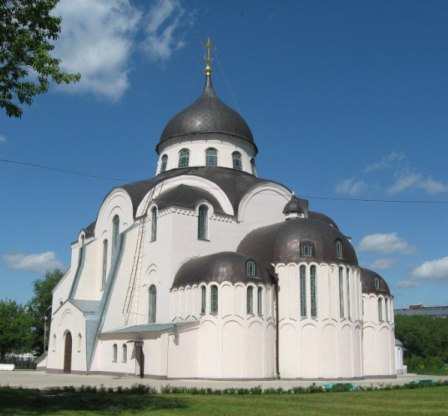

Monastery of Christ's Birth is a medieval Russian Orthodox Monastery. It is hard to pinpoint the exact date of its foundation, but it is certain that it had a large number of nuns when it was first mentioned in official documents in 1514.
Main Buildings of the Monastery
| Cathedral of the Nativity of
Christ (1820)
|
Cathedral of the Resurrection
of Christ (1913)
|
Royal Martyrs Church (2006)
|
| Hospital Trinity Church (1830- 32) | The Gate Church of the Saviour, abbot's cell, sacristy, refectory (1801- 05) |
History
It is not known exactly who and when
founded the Nativity of Christ Monastery in Tver. First mentioned in
a letter dated 1514. There is a widespread tradition that the
monastery arose at the beginning of the 15th century with the
blessing of the saint and miracle worker Arseny, Bishop of Tver.
During the Time of Troubles, the monastery was ruined, for a
long time it was in decline. But from the end of the 17th century he
began to improve and achieved a better position. Nevertheless, until
the beginning of the 19th century, all the buildings of the
monastery remained wooden. The main shrine of the monastery was the
miraculous Tikhvin icon of the Mother of God, brought to the
monastery in 1703.
The monastery ensemble in the style of
classicism was formed in the first half of the 19th century. The
initial funds for the construction work came from Countess Anna
Irodionovna Chernysheva. A gate church was erected on them, as well
as abbot chambers with a sacristy and a refectory. It cannot be
ruled out that the project of these buildings was prepared by N. A.
Lvov.
The countess's initiative was supported more than once
by the wife, mother and sisters of Emperor Alexander Pavlovich who
visited the Nativity of Christ monastery. At their expense, a heavy
five-domed monastery cathedral is being built. The building was
roughly finished in 1812, but in September 1813 it suddenly
collapsed at night. None of the nuns suffered, since at the time of
the Napoleonic invasion all the nuns were evacuated to the
Molo-Afanasyevsky monastery.
The construction of a new
cathedral according to a project typical of the Empire era is often
attributed to K.I. Rossi, who lived in Tver at that time. No
documentary evidence of authorship has survived. In 1820, the new
cathedral was consecrated by Archbishop Filaret (Drozdov) of Tver.
Before the revolution on June 26, a religious procession was
held annually with a large gathering of pilgrims. At the monastery
there was a school for girls of clerical rank. The monastery was
crowded and regularly visited by pilgrims.
In the 1920s, the
monastery was abolished, the surviving buildings were used as
utility rooms, and after the Great Patriotic War, the Nativity
Cathedral served as a gym. In 1988, the Resurrection Cathedral was
returned to the faithful, and the monastery itself began to revive
from April 1, 1999.
As of 2010, the Savior Church with the
abbot's building has been completely renovated. The destroyed brick
fence and the bell tower are being restored. The interior of the
Nativity Cathedral, which fell into complete desolation during the
Soviet years, has not yet been restored.
In 2018, the
historical buildings of the monastery were donated to the Tver
Diocese of the Russian Orthodox Church for free use.